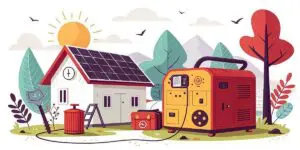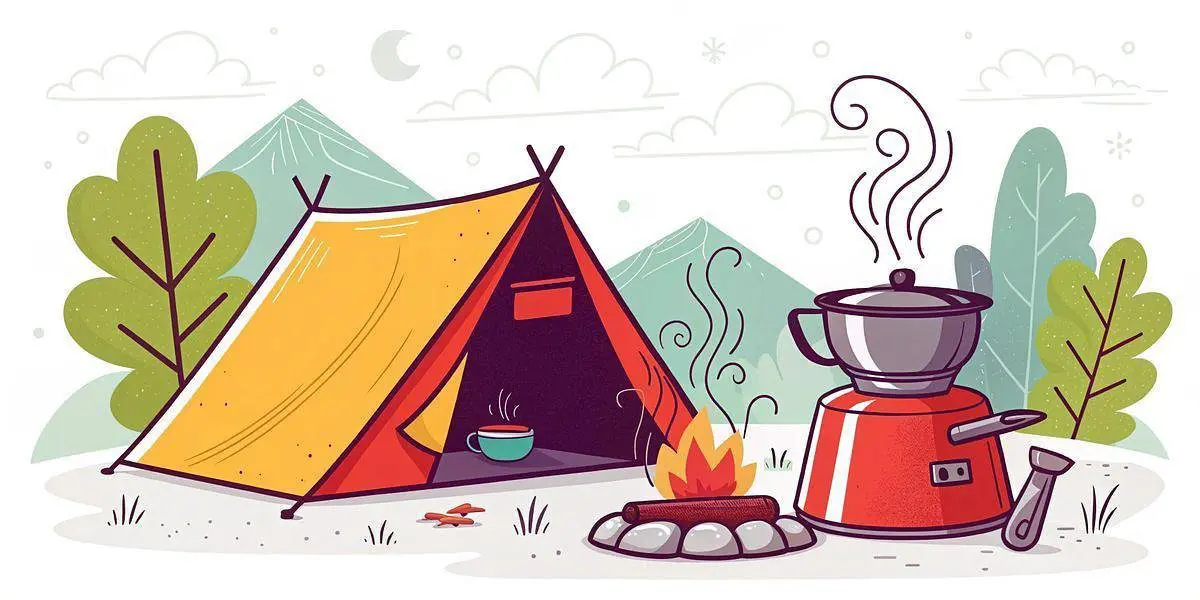Introduction
A bugout location is a designated safe haven where you can retreat in the event of a crisis. For preppers, having a secure bugout location is crucial. It provides a sanctuary away from immediate threats and ensures your long-term survival.
Choosing the right bugout location requires careful thought and consideration. Various factors determine its suitability, impacting your overall preparedness strategy. Proximity to natural resources is crucial for survival and success in emergencies. Selecting a well-thought-out bugout location can significantly influence your ability to navigate crisis situations successfully.
1. Proximity to Current Location and Ease of Access
Choosing a bugout location requires careful consideration of the distance between your current residence and the potential site. Finding the right balance is key: staying far enough to avoid immediate dangers, but still being close enough to reach them when needed.
Key points to consider:
- Distance: A location too far can become unreachable in a crisis, while one too close might not offer enough safety.
- Transportation options: Consider multiple forms of travel—vehicles, bicycles, or even on foot. Each mode of transport has its benefits and limitations.
- Accessibility: The area should be accessible under various conditions (e.g., roadblocks, weather changes). This includes considering terrain types and potential obstacles.
Ensuring safe access to your bugout location can significantly enhance your chances of successfully evacuating during an emergency.
2. Avoiding High-Density Population Areas
Locating your bugout property near high-density population areas can pose significant risks during a crisis. High-population zones are more susceptible to:
- Social unrest: In times of emergency, densely populated areas often experience heightened tension and conflict. The concentration of people can lead to increased crime rates and civil disturbances, putting your safety at risk.
- Resource shortages: Urban and suburban areas may face rapid depletion of essential supplies like food, water, and medical resources. This scarcity can escalate competition for limited resources, making it difficult to secure what you need for survival.
Choosing a more remote location helps mitigate these risks, ensuring a safer and more reliable environment for your bugout plan.
3. Securing a Reliable Water Source
Having a reliable water source is imperative for a bugout location. Access to clean and sustainable water can greatly impact your survival, so it’s important to prioritize evaluating this aspect.
Evaluating Natural Water Sources
Here are some key points to consider when assessing natural water sources:
- Springs: Natural springs provide continuous, fresh water and are generally safe if well-maintained. Having a spring nearby can be a major advantage.
- Rivers and Streams: These can offer abundant water supply but may require purification methods to ensure safety. It’s crucial to check the consistency of flow and identify any potential sources of contamination upstream.
- Well Water: Wells are a reliable source of water, but they require regular maintenance and testing to ensure quality. Consider the depth and yield of the well before finalizing your bugout location.
- Location: The proximity of your bugout location to these water sources is crucial. It should be within a reasonable distance for easy access, but not so close that it compromises your safety or privacy.
Remember, having multiple sources of water is ideal for redundancy and resilience. So, carefully assess the availability and reliability of water sources when choosing your bugout location.
Implementing Rainwater Harvesting Systems
Rainwater harvesting is another effective method to secure a steady bugout location water supply. By setting up a system of gutters, downspouts, and storage tanks, you can collect rainwater for various uses.
Here’s what you need to know about rainwater harvesting:
- Gutter Systems: Install gutters on structures to channel rainwater into storage tanks.
- Filtration: Incorporate filtration systems to make harvested rainwater drinkable.
- Storage Tanks: Use durable tanks designed for long-term water storage to ensure you have enough supply throughout the year.
Securing a reliable water source is one of the most critical aspects of your bugout strategy as it enhances your chances of long-term survival.
4. Shelter and Security Considerations
Adequate shelter and security are also necessary at your bugout location. A well-designed bugout location shelter should provide both protection from the elements and security against potential threats.
Key considerations include:
- Utilizing Natural Features for Concealment: Position your shelter in a manner that leverages natural terrain, such as hills or dense foliage, to remain hidden from prying eyes. Camouflage techniques can also be employed to blend your shelter with the surrounding environment.
- Reinforcing Existing Structures: Enhance the security of any pre-existing buildings by fortifying doors and windows, installing secure locks, and using durable materials that can withstand attempts at forced entry.
- Security Measures: Implement additional security measures like perimeter alarms, tripwires, or motion sensors. These can provide early warnings of intruders, giving you ample time to react.
- Shelter Design: Consider the design of your shelter for maximum efficiency and safety. Structures such as underground bunkers or cabins built with solid construction materials can offer more substantial protection.
By making sure your bugout location is equipped with a strong shelter and reliable security measures greatly contributes to your preparedness strategy.
5. Self-Sufficiency and Resource Availability
Self-sufficiency is the primary purpose of a bugout location. Assessing the availability of natural resources in the surrounding area plays a significant role in achieving long-term self-reliance. Key aspects to consider include:
- Food Production: Practicing sustainable strategies like organic gardening enables you to grow your own food. Consider the soil quality, sunlight exposure, and growing seasons for various crops. Also consider stocking some emergency supplies in place such as a seed bank.
- Water Resources: Although we covered water above we’ll give it another mention here….it’s that important.
- Energy Solutions: Renewable energy systems like solar panels or wind turbines can provide consistent power. Check the potential for solar energy based on sunlight availability and wind patterns for wind energy.
Implementing some or all of these methods not only ensures resource availability but also enhances your bugout location’s self-sustainability, making it a viable location during extended crises.
6. Considering Financial Factors and Legal Considerations
When choosing a bugout location, it’s important to think about the financial aspects and legal considerations. Though we may have it for a total collapse scenario, we have to maintain it now (assuming actual ownership), and that impacts our day to day life to an extent. Here are two key factors to keep in mind:
Financial Factors
The cost of living in an area can have a big impact on your budget for your long-term survival plan. Here are some financial factors to consider:
- Property Taxes: Look into the property taxes of the potential bugout location. High taxes can put a strain on your finances over time.
- Maintenance Costs: Owning a property comes with maintenance responsibilities. Think about the costs of repairs and upkeep that you may need to budget for.
Legal Considerations
Local regulations and laws can affect your ability to live self-sufficiently in a bugout location. While they may (would not likely stand) in a nationwide crisis, it’s worth considering them from a localized crisis. Say a nuclear plant melts down, effecting your primary home and you go to your bugout location. It may not be impacted, and therefore you still have to deal with traditional laws, and such there. It’s essential to understand these legal considerations before making a decision:
- Zoning Ordinances: Research the zoning ordinances of the area to find out what activities are allowed on the property. Here are some specific areas to look into:
- Gardening and Farming: Some places have restrictions on the types of crops you can grow or animals you can raise.
- Building Codes: Check if there are any limitations on building shelters, outbuildings, or sustainable energy systems like solar panels.
- Water Rights: Make sure you have legal access to water sources on or near the property.
By considering these financial factors and legal considerations, you’ll be able to make more informed decisions about any potential hidden costs or legal obstacles that may come with your chosen bugout location.
7. Evaluating Environmental Hazards and Disaster Vulnerability
Assessing potential environmental risks is crucial for ensuring your bugout location’s safety. Location-based threats like floods, wildfires, and other natural disasters can drastically and directly affect your survival prospects.
Factors to Consider:
- Flood Risk: Check historical flood data and proximity to bodies of water. Ensure your property is on higher ground.
- Wildfire Susceptibility: Evaluate the vegetation around the area. Regions with dense forests may be more prone to wildfires.
- Earthquake Zones: Investigate fault lines and seismic activity in the area.
- Hurricanes and Tornadoes: Coastal areas might face hurricanes while central regions could deal with tornadoes. Also consider whether your construction is up to par to dealing with a reasonable hit by one of these in the area.
Mitigation Strategies:
- Building elevated structures to avoid flood damage.
- Creating a defensible space by removing flammable vegetation around your shelter.
- Using earthquake-resistant construction techniques for buildings in seismic zones.
Researching these factors helps you anticipate challenges and develop preparedness measures, enhancing your bugout location’s safety.
Conclusion
Choosing a bugout location wisely can make all the difference in your ability to survive and thrive during a crisis. Remember to keep these factors in mind:
- Proximity and accessibility
- Avoiding high-density population areas
- Securing a reliable water source
- Shelter and security considerations
- Self-sufficiency and resource availability
- Financial and legal considerations
- Evaluating environmental hazards
It’s important to be adaptable and flexible because unexpected events may require you to change your plans. While finding the perfect bugout location is important, don’t forget about the value of acquiring skills and building connections within your community as part of your overall preparedness strategy.
Get involved with local groups, participate in workshops, and never stop learning. By combining a well-chosen survival retreat with your own personal readiness, you’ll greatly increase your ability to handle any crisis that comes your way.





























